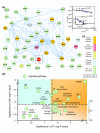Genomic chart guiding embryonic stem cell cardiopoiesis
- PMID: 18184438
- PMCID: PMC2395240
- DOI: 10.1186/gb-2008-9-1-r6
Genomic chart guiding embryonic stem cell cardiopoiesis
Abstract
Background: Embryonic stem cells possess a pluripotent transcriptional background with the developmental capacity for distinct cell fates. Simultaneous expression of genetic elements for multiple outcomes obscures cascades relevant to specific cell phenotypes. To map molecular patterns critical to cardiogenesis, we interrogated gene expression in stem cells undergoing guided differentiation, and defined a genomic paradigm responsible for confinement of pluripotency.
Results: Functional annotation analysis of the transcriptome of differentiating embryonic stem cells exposed downregulated components of DNA replication, recombination and repair machinery, cell cycling, cancer mechanisms, and RNA post-translational modifications. Concomitantly, cardiovascular development, cell-to-cell signaling, cell development and cell movement were upregulated. These simultaneous gene ontology rearrangements engaged a repertoire switch that specified lineage development. Bioinformatic integration of genomic and gene ontology data further unmasked canonical signaling cascades prioritized within discrete phases of cardiopoiesis. Examination of gene relationships revealed a non-stochastic network anchored by integrin, WNT/beta-catenin, transforming growth factor beta and vascular endothelial growth factor pathways, validated by manipulation of selected cascades that promoted or restrained cardiogenic yield. Moreover, candidate genes within anchor pathways acted as nodes that organized correlated expression profiles into functional clusters, which collectively orchestrated and secured an overall cardiogenic theme.
Conclusion: The present systems biology approach reveals a dynamically integrated and tractable gene network fundamental to embryonic stem cell specification, and represents an initial step towards resolution of a genomic cardiopoietic atlas.
Figures





References
-
- Suzuki A, Raya Á, Kawakami Y, Morita M, Matsui T, Nakashima K, Gage FH, Rodríguez-Esteban C, Belmonte JCI. Maintenance of embryonic stem cell pluripotency by Nanog-mediated reversal of mesoderm specification. Nat Clin Pract Cardiovasc Med. 2006;3:S114–S122. doi: 10.1038/ncpcardio0442. - DOI - PubMed
Publication types
MeSH terms
LinkOut - more resources
Full Text Sources
Other Literature Sources
Molecular Biology Databases

